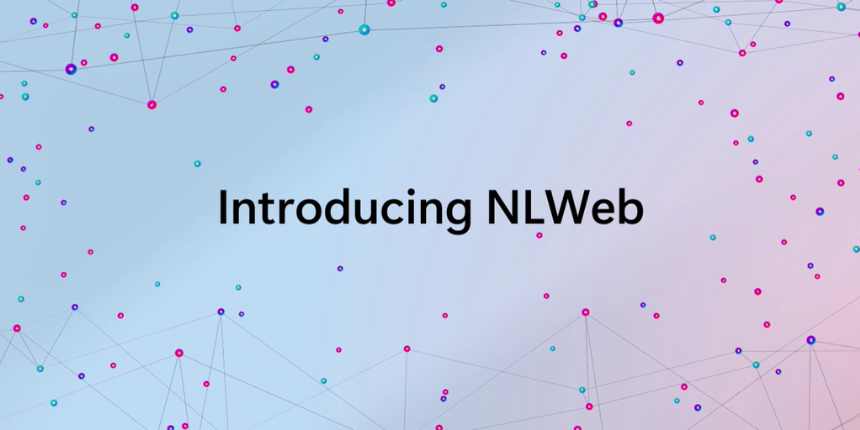

A new open-source protocol from Microsoft may reshape how users interact with websites—and how websites respond.
Announced at the Build 2025 conference, NLWeb (Natural Language Web)signals a move toward making web experiences more conversational. Rather than clicking through layers of navigation, users could soon ask questions in plain language on a brand’s website—not a third-party chatbot—and receive tailored, relevant responses.
This isn’t just a new way to search; it’s a potential redefinition of how websites are built, optimized, and measured. NLWeb builds on existing web standards but extends their function in a way that could change how both people and AI agents access content.
In this article, we’ll break down what NLWeb is, how it works, and why it matters. We’ll also explore the implications for SEO, user experience, analytics, and what businesses should start doing today to be ready for what comes next.
A natural language interface for any website
NLWeb, short for Natural Language Web, is an open-source protocol introduced by Microsoft. Its goal is to allow websites to support natural language queries, turning static content into something users and AI agents can search and interact with conversationally.
Unlike traditional navigation menus or keyword-based site search, NLWeb enables users to type or speak full questions directly on a website. These questions are answered by drawing on the site’s structured content, including Schema.org markup, sitemaps, and RSS feeds. In other words, it leverages content that many websites already have, but adds a new way to access it through everyday language.
The real innovation lies in how this model treats a website. With NLWeb, a site is no longer just a destination for users to explore. It becomes a source of information that can be queried programmatically, not only by people but also by AI systems. These AI agents can now discover and interpret web content using the same protocols as human users.
This positions NLWeb as more than a UX update. It’s a step toward a more interactive and intelligent web, where structured content becomes the foundation for richer, more intuitive digital experiences.
How does NLWeb actually work?
NLWeb is powered by a new framework called the Model Context Protocol (MCP). This protocol connects structured web content with large language models, making it possible for both people and AI agents to interact with a website through natural language.
A key function of MCP in this context is a published “ask” endpoint, which is a specific location on a website where queries can be sent and interpreted. Instead of waiting to be indexed by search engines, websites become accessible in real time, allowing AI models to retrieve precise information based on a site’s existing metadata and structure.
MCP is designed to be open and flexible. It works with a range of AI systems, including models from OpenAI, Google, and Anthropic, without requiring any single provider. This flexibility allows websites to participate in a broader, evolving ecosystem.
For businesses, this means greater potential visibility. Content can now be accessed not just through traditional search engines, but also through AI-powered interfaces that prioritize relevance, context, and clarity.
What NLWeb means for SEO
Structured data has long been a foundational part of search engine optimization. It helps search engines understand what’s on a page and often powers rich results, like product listings, event previews, or recipe cards. With NLWeb, that same structured data plays an even more important role—not only helping websites rank in search but making them readable and useful for AI agents and conversational models.
When a site implements an NLWeb endpoint, it allows AI agents and tools powered by large language models to interact with site’s structured content directly. These models rely heavily on structured information to interpret and respond to user prompts accurately. The better a site’s metadata is organized, the more likely it is to return clear, relevant answers through natural language interfaces.
This increases the pressure on technical SEO to ensure that markup is consistently implemented and easy for models to interpret. Content types like recipes, product specs, FAQs, or how-to guides should be fully marked up using Schema.org or similar standards. Taking shortcuts, such as relying on JavaScript to inject schema, can create gaps in how that data is processed.
NLWeb also shifts the idea of visibility. Instead of optimizing only for traditional SERPs, teams will need to consider how content is discovered and understood in this new, AI-first layer of the web. It’s a broader view of SEO, one that requires precision, structure, and collaboration between content, development, and technical teams.
Stay Forward
Get exclusive insights into digital
media's top-trending topics delivered
directly to your inbox.
How NLWeb changes the user experience
NLWeb introduces a new way for users to interact with websites, shifting the experience from structured clicks to open-ended conversations. As a result, familiar patterns of navigation, engagement, and measurement may begin to evolve.
Rather than clicking through menus, users can query a site directly, asking specific or nuanced questions in natural language. This makes the experience more fluid and personalized. This shift puts pressure on UX design to prioritize accessibility, modular content, and clear information architecture that can support non-linear journeys.
Performance is another area that could be affected. Real-time query responses, especially those powered by large language models or semantic search, introduce added processing. This may impact page load times and responsiveness, which are core UX concerns.
Finally, traditional engagement metrics may not reflect how users interact in a conversational environment. UX teams and analysts may need to consider new indicators, such as query depth or the coherence of conversational flows, to understand how users are engaging.
These changes won’t take hold overnight, but they do hint at a more adaptive, intent-driven model of UX design and digital experience.
What should brands do next?
Businesses don’t need to overhaul everything immediately, but there are clear steps they can take now to prepare for what’s coming—especially across content, infrastructure, and measurement.
- Start with yourstructured data. Audit your site’s schema, sitemaps, and RSS feeds to ensure they are complete, accurate, and rendered in a way that AI models can reliably access. Avoid JavaScript-dependent implementations where possible, and ensure that high-value content types, like products, recipes, FAQs, or location pages, are fully marked up.
- Evaluate whether your content is ready to be served in a conversational format. This means thinking beyond keywords and considering how clearly information is organized, how questions are answered, and how modular the content is.
- Technical teams should explore whatimplementing an “ask” endpointmight involve. While not every business will need to move immediately, understanding the protocol and tracking adoption will help teams stay ahead.
- Finally, align your UX and analytics strategies. Define what success looks like in a query-based experience, and begin identifying new engagement metrics that reflect intent and depth, not just clicks.
These early steps will improve how your site performs today and ensure it remains discoverable and relevant as the web continues to evolve.
Contributing Experts
Stay Forward
Get exclusive insights into digital
media's top-trending topics delivered
directly to your inbox.




